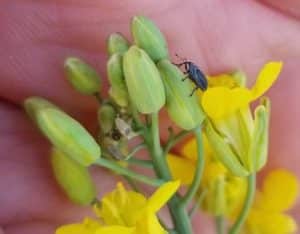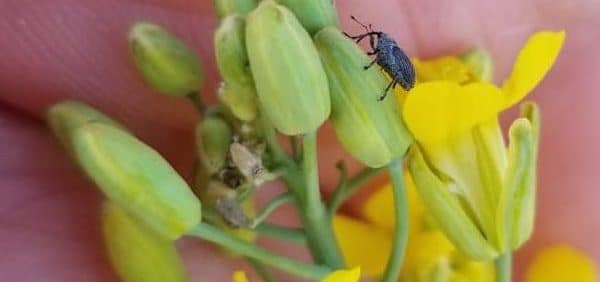Cabbage seedpod weevil. Dry conditions last August could mean lower numbers for 2019, but you still want to scout. Scout at 10-20% flower (or approximately one week after first flower) using a sweep net. The action threshold for applying insecticides is 25-40 weevils in 10 sweeps. Read more on scouting and thresholds. Share your results: Alberta.

Bertha armyworm. Manitoba adult trap counts are generally low so far, with only one trap reporting more than 300 adults (cumulative for the year), which is the threshold between low and medium risk. Alberta is similar, with only two sites so far with more than 300. Saskatchewan’s map, when ready, will be posted here, but the highest count so far is at Rudy and the number is only 131. These adult counts are done to indicate possible risk areas for larvae later in the season.
Grasshoppers. Grasshoppers are causing some problems in areas that remain dry. As for areas that got rain, the rapid crop growth that results should reduce the economic risk from grasshoppers. Rain also tends to predispose grasshoppers to fungal, bacterial and viral infections. Nymphs can also be knocked off plants and drown in puddles. More rain is better, when it comes to these natural population control measures, and one rain event is not enough – particularly for the fungal infection. Moisture needs to be sustained, and warm humid weather afterward adds to infection severity. Read more for thresholds and scouting tips.
Lygus. We don’t have reports of lygus issues, but we want to highlight a 4-year research study published in 2019. It assessed the impact of cabbage seedpod weevil control on lygus bug levels later in the season. The study found that fields flowering early enough to require control for cabbage seedpod weevil were not fields that later experienced high lygus infestation. Growers should continue to scout and manage cabbage seedpod weevil and lygus bug separately (Hector Carcamo 2019). Lygus scouting, thresholds and timing.
Diamondback moth larvae. Beneficial pathogens and insects usually keep the population in check, but scout anyway to make sure. Diamondback moth normally do the most damage to canola when leaves are senescing and larvae are moving onto pods to feed. Consider insecticide application when 200 to 300 larvae per square metre (20 to 30 per square foot) are present at the advanced pod stage. Read more.
